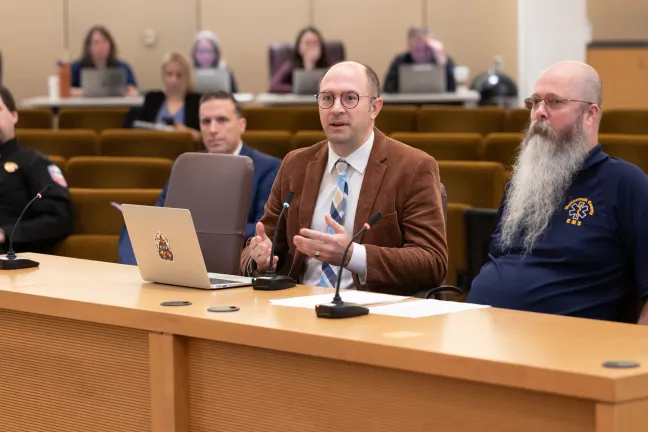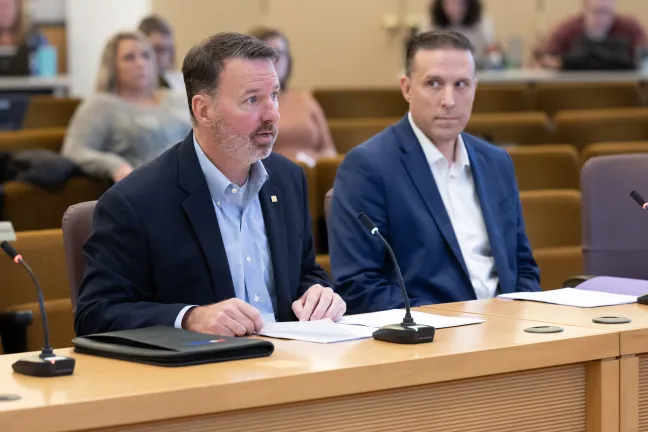The Board of County Commissioners today learned the steps American Medical Response (AMR) has taken since the Board approved a new 12-month staffing pilot to improve slow response times.
In August, and after four months of mediation, the Board unanimously approved a County agreement with AMR to address more than two years of lagging ambulance response times while maintaining safety and quality medical care.
The agreement permitted a “ramp up” period through Nov. 1 to provide AMR with additional time to operationalize staffing changes and achieve strict compliance with new staffing models.
AMR briefed the Board today on the actions the company has taken in the past three months to come into contract compliance. AMR executives also described some ongoing challenges.
“The information presented by AMR is trending in the right direction,” said Health Officer Dr. Richard Bruno. “AMR’s hiring, the increased availability of ambulances and apparent trend toward compliance are all encouraging. As implementation continues, the County will keep working to ensure quality, equitable and timely services are delivered to the community.”
The County is charged with ensuring people receive ambulance services in a timely and equitable way. The Health Department oversees the sole-source contract with AMR to provide the lifesaving service.
“Three months ago today, Multnomah County and AMR concluded a successfully negotiated mediation and charted a path forward to improve ambulance services in this community,” said Chair Jessica Vega Pederson.
“And on this path forward, transparency is critical. Continuing this commitment to a transparent process is what today is all about. As we reach the conclusion of the ‘ramp up’ period to operationalize the ambulance staffing changes the Board approved in August, we’re having this briefing to learn more about what AMR has done in the months since the completion of mediation, where we stand today and where we’re going.”
AMR executives told the Board that since August, they have on-boarded 65 Emergency Medical Technicians (EMTs) in the Multnomah County system, with an additional 13 coming aboard in November. Since the agreement was signed, AMR has also hired 14 new paramedics.
“Today, we are aligned. We are pulling in the same direction. We have mutually shared goals,” said Rob McDonald, regional director for AMR.
The 12-month pilot tests a blended staffing model that will maintain two paramedics on a minimum of 20 advanced life support (ALS) ambulances, allow one paramedic and one EMT on new hybrid ALS ambulances, and maintain basic life support (BLS) ambulances staffed by two EMTs.
“While we’ve observed meaningful progress, we must underscore critical areas where further improvements are essential, especially in EMT training, compensation, and communication,” said Austin DePaolo in a letter to the Board of Commissioners. DePaolo is with Teamsters Local 223, the union representing AMR paramedics.
Chair Vega Pederson requested AMR return to the Board on a quarterly basis to report back on their continued work and progress. Commissioners said they were particularly interested in learning about any adverse impacts to care quality and patient safety during the pilot. Multnomah County EMS managers said they will continue to monitor and evaluate these metrics as the strict compliance period begins.
One of the provisions in the Settlement Agreement granted the County specific permission to publicly share de-identified and aggregated monthly reports about AMR’s compliance with response times and other contract metrics.
The Multnomah County Health Department used the ramp up period to develop the tools to publicly share response time data. The Health Department presented to the Board three new interactive reports. Those can be found on this page under the header titled Ambulance Response Data Reports, and will be updated monthly. The aggregated data of monthly numbers of incidents, by geographic zone and call response type, can all be found by clicking on the columns in the chart, or by utilizing the download function in the Tableau dashboard.
“Securing a provision in our mediated agreement to share data publicly was a really important condition for us to ensure that we’re able to improve transparency and information sharing with the Board and the public moving forward as these staffing changes take effect,” said Dr. Bruno.
###


